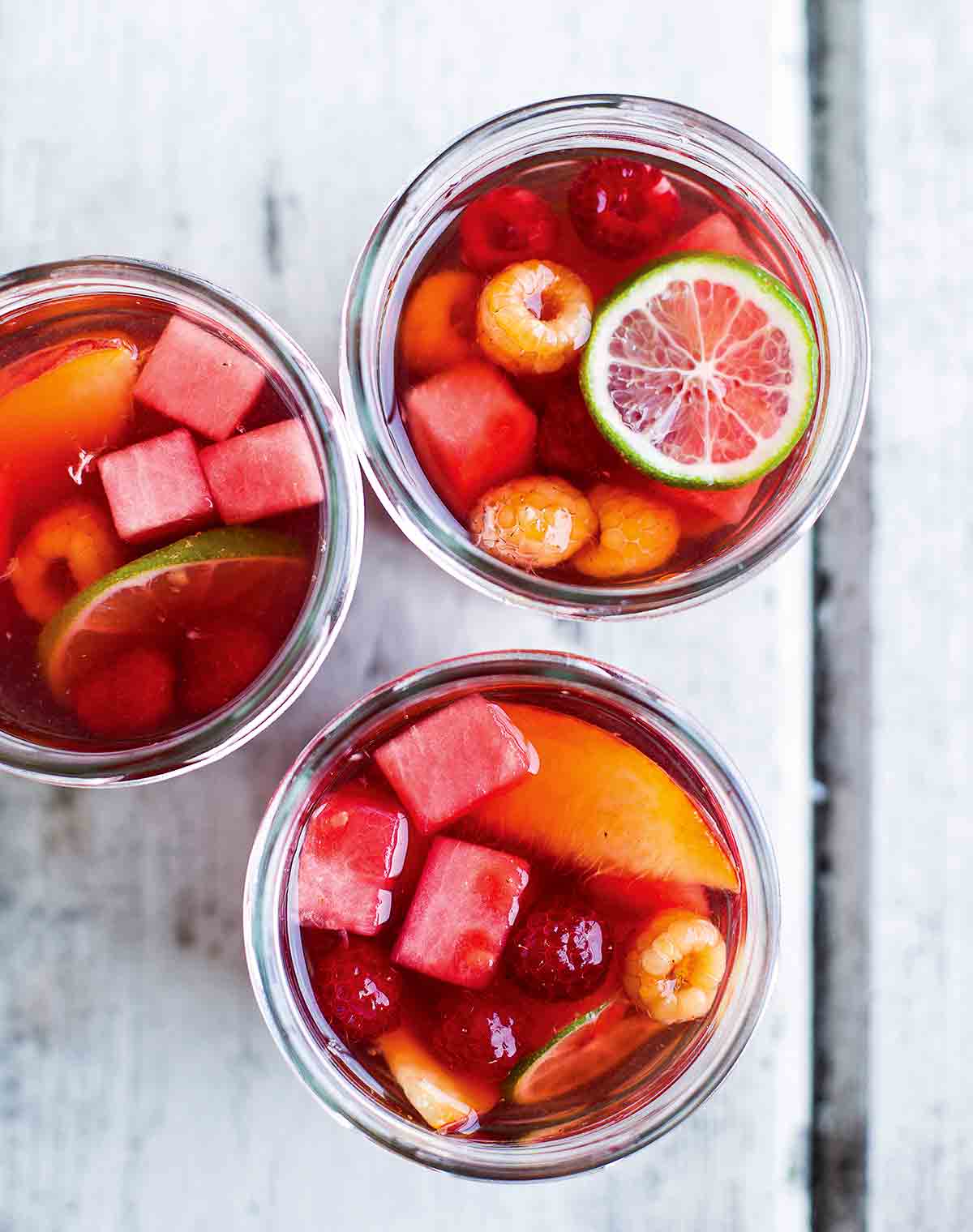
For this rosé sangria recipe, swapping the more commonly found fruit in the wine, usually apples and oranges, for a mix of seasonal berries or fruit, like lovely golden raspberries along with juicy watermelon, adds a welcome, summery twist to this pink-hued drink.
I prefer to use agave nectar with cold drinks because it blends more easily than honey, but if you have honey on hand, it’s just fine as a substitute. [Editor’s Note: You could also swap some simple syrup for the agave if that’s what you have on hand. You’ll sacrifice a touch of complexity, though we’ve gotta admit, we’ve had no complaints.]–Kimberley Hasselbrink
Rosé Sangria FAQs
Color is the main indicator of a great peach. We love the fragrance of fresh peaches, but that can be deceiving – so always look for bright, vibrantly colored fruits. Nothing dull or wrinkly.
Give the peach a very gentle squeeze at the tip and where the stem was – if it just starts to give, it’s ripe and ready to eat. Once you’ve picked your perfect peaches, gently carry your treasures home and store them at room temperature, stem side down.
Need more info? Check out these tips on how to tell if a peach is perfectly ripe.
Agave nectar is actually agave syrup – but is sometimes labeled as nectar for marketing purposes. (Nectar sounds healthier than syrup.) Agave nectar comes from the blue agave plant – the same plant used to make tequila.
Nothing makes a swanky rosé sangria like summer fruits in place of the expected apples and oranges. And while we’ve no complaints whatsoever about the watermelon and raspberries included in the recipe below, we’re sorta partial to stone fruits—so much so that next time we make this recipe, we just may be tempted to toss in some cherries and chopped plums along with everything else. But that’s just us.
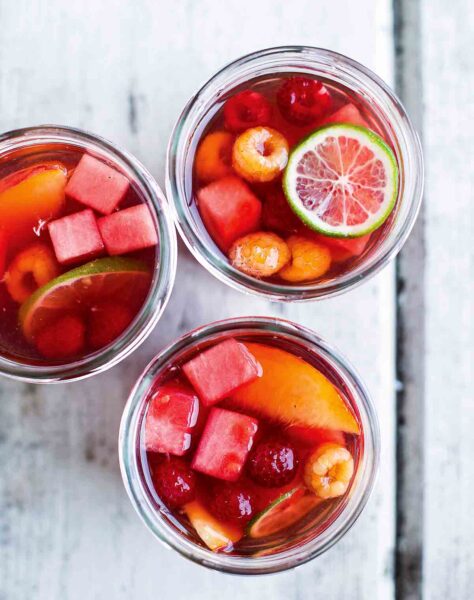
Rosé Sangria
Ingredients
- One (26-ounce) bottle crisp, dry rosé
- 3 tablespoons orange liqueur, such as Curaçao, triple sec, or Grand Marnier
- 3 tablespoons agave nectar or honey, or more to taste
- 1 cup raspberries, preferably a mix of golden and red
- 1 cup cubed watermelon
- 1/2 peach or nectarine, unpeeled but with fuzz wiped off, thinly sliced or chopped
- 6 thin slices lime
- Ice, for serving
Instructions
- In a large pitcher, combine the rosé, orange liqueur, and agave nectar. Add the raspberries, watermelon, peach, and lime and gently stir to combine.
- Refrigerate until chilled through, 3 to 4 hours (but no more than that or the fruit may turn soggy).
- Serve the rosé sangria cold, preferably over ice.
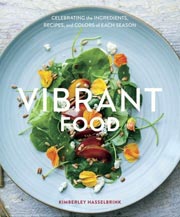
Nutrition
Nutrition information is automatically calculated, so should only be used as an approximation.
Recipe Testers’ Reviews
This rosé sangria recipe is very delicious. It’s also very pretty with the peaches, watermelon cubes, raspberries, and lime slices floating in it. We really enjoyed the mix of fruits as an alternative to the classic apples and oranges.
The recipe worked very well as written, however, I think you can adjust the kind and amounts of fruits to your own liking. I cut the watermelon and peaches into 3/4-inch dice so that they were all about the same size as the raspberries and easy to eat with a spoon.
I’ve made a lot of different versions of sangria, so I was interested to try this rosé version. The addition of Grand Marnier and watermelon was something new and different.
I layered the fruit in a beautiful pitcher and didn’t stir it until we were ready to serve. The presentation was beautiful—the limes looked particularly beautiful against the color of the sangria. It was really tasty and refreshing. The perfect drink for our 4th of July cookout.
I had an open bottle of rosé on hand, so I made a half batch of this lovely rosé sangria today. This recipe is quick—really quick. It’s easy to prepare and the perfect summertime beverage.
I used triple sec because I had it on hand. I added a bit more agave nectar as I enjoy my sangria on the sweet side. I cut the watermelon really small—like 1/4-inch cubes—and did the same with the peaches. I left the raspberries whole and only used red ones.
Sometimes I like to freeze small cubes of fruit in my ice cubes for a pretty looking cube. I couldn’t wait 3 to 4 hours to drink it, but I would imagine it would get even better as the flavors have some time to blend. It’s a very respectable sangria recipe to add to my collection.
Some sangria is too heavy on the citrus, giving it a slightly bitter flavor. I have also had sangria made with a very heavy–and maybe not the best–red wine. I used a very nice Spanish rose, Grand Marnier, and some local honey. The agave would have been easier to blend.
I made 1/2-inch cubes of watermelon and sliced the peaches. I liked the contrast between the shapes of the berries, melon, and peaches. This is an easy recipe to throw together—it took me all of about 15 minutes to make—and just leave to chill.
This rosé sangria is a very refreshing drink for a hot evening. Next time, I may try adding a splash of sparkling water. I also like the fact that this is not sickeningly sweet.
This was a very pretty and sophisticated rosé sangria, especially nice as an alternative to a Crémant. I used a dry Côte de Provence (Domaine De La Fouquette 2013 Cuvée Rosée d’Aurore), red raspberries, 1/2-inch cubes watermelon, honey, and Bols triple sec.
If you’re using honey and it isn’t super runny, warm it slightly to make sure it’s stir-able, then add the orange liqueur and stir until the honey is dissolved. Add 1/2 cup wine and stir to combine before adding the rest of the wine and the fruit.
Using Grand Marnier or Curaçao would certainly play nicely and maybe shade the flavor of the sangria a little more complex, but I was happy with Bols, a nice clean-tasting version of triple sec. I deliberately sought out a dry rosé, and I think any worries I had that this would be all together too sweet were tossed aside with the result.
I’ll gladly be serving this as an aperitif for our next summer event. The results were lovely and floral — I think the floral notes come from a combination of the limes, honey, and peaches.
The thinly sliced peaches were nicely softened after 4 hours. The lime would be overpowering if you left it in for too much longer, but since you won’t likely have leftovers, that isn’t an issue. In the unlikely circumstance that you DO have leftovers, you might want to strain it before refrigerating and add fresh fruit the next day.
Serve the sangria in small tumblers and maybe make small demitasse spoons available because your guests will want to eat the fruit. The watermelon seemed a minor item but was definitely part of the whole flavor palette.
I think raspberries were the most important item—they were beautiful and tasted just right in the wine and I wouldn’t want to make substitutions. If I cannot find golden raspberries next time, maybe I will try a yellow watermelon for the lovely color and sweetness. It’s going to look so inviting when I present a tray of sangrias to start my next party!
This gorgeous rosé sangria recipe was perfect for our weekend July 4th cookout. I love a dry rosé but have never thought to use it as the base for a sangria. It was lovely in terms of its flavor combinations and appearance.
I used a crisp California rosé, triple sec, and local honey instead of agave nectar, which gave the drink a tiny bit of welcome sweetness. I also used red raspberries, 1 cup cubed watermelon cut into 1/2-inch chunks, and a thinly sliced nectarine instead of a peach.
The recipe says to serve over ice, but I found it to be already perfectly chilled right out of the pitcher. I didn’t want the ice to water the drink down, either. This was a quick and very tasty sangria recipe that we all really enjoyed.
This rosé sangria recipe, prepared as written, yields a nice, refreshing summer sangria. However, allowing the delicate raspberries and watermelon to chill for 4 hours yielded slightly mushy fruit. My suggested augmentations:
1) A quick raspberry puree added with other liquids yields a nice flavor and additional color
2) Add watermelon (1/2 inch cubes) and raspberries 15 minutes before serving
3) Cut peaches in 1/2 inch cubes rather than slices for simple enjoyment of fruit
4) Consider adding blueberries, cubed pineapple, and kiwi
5) Use halved kumquats in place of lime slices for a unique twist
I often have trouble choosing between red and white sangria, so I was more than happy to let this recipe make the decision for me. Anyone hankering for a heavier sangria may wish to stick with the traditional red sangria, but as a fan of both kinds of sangria, I thought this rosé sangria was a nice compromise.
I also preferred the selection of fruit here to more common fruit options, both for flavoring the sangria and for eating afterward. Other high-season fruits could certainly be swapped in. The amount of fruit was sufficient; however, it wouldn’t hurt for the sangria to have a fruitier presence, whether by puréeing some of the fruit beforehand or steeping it longer.
My testers were quite eager and I failed to realize that the sangria was supposed to be made ahead of time, so I’m afraid it only chilled an hour in the freezer. We found it more than drinkable by then, but obviously the fruit flavor would be more present and the temperature lower had I chilled it the max time.
The rosé makes for a sightly presentation, even more than your standard sangria. Next time, I’ll opt for bubbles and use a sparkling rosé.





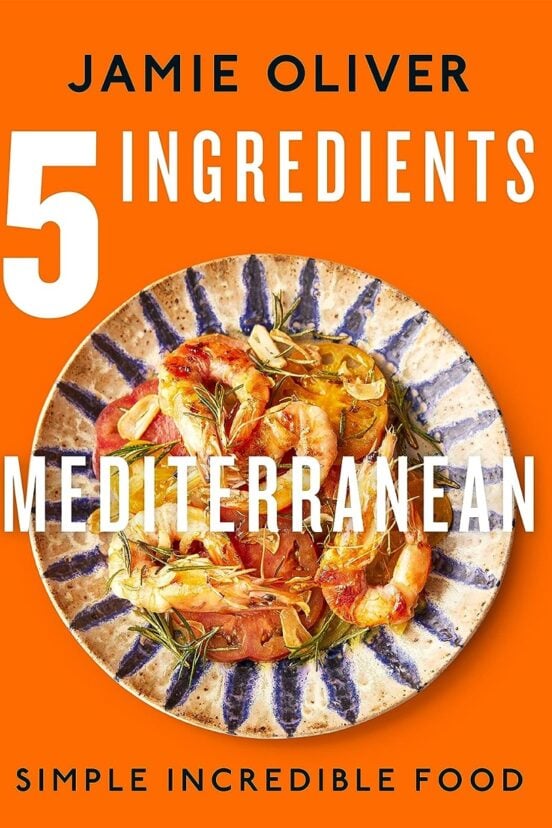
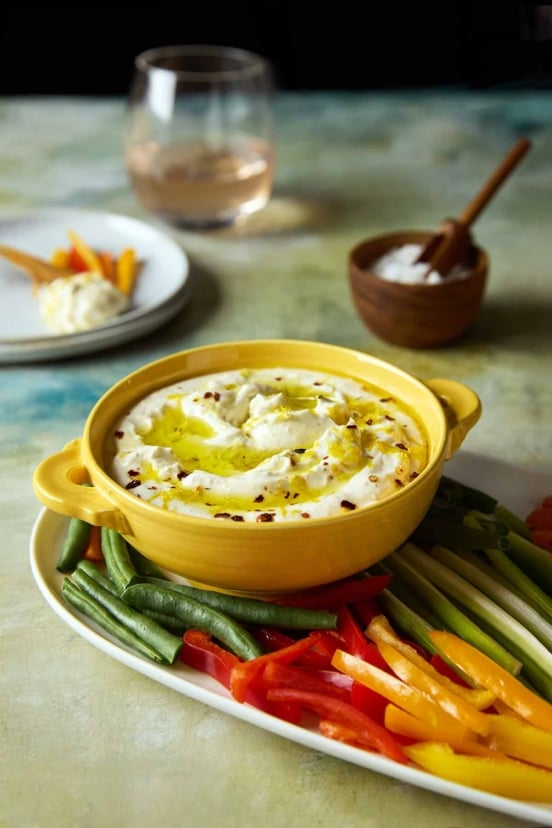
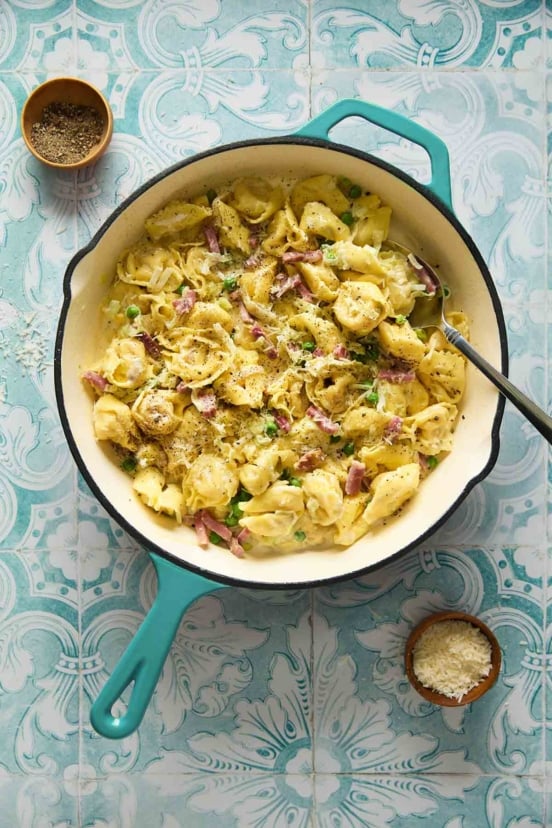









I made this yesterday afternoon for an evening get together. I used a dry rosé from Mendicino Valley. I followed the recipe pretty much as written, with the following adjustments: I cut down on the agave nectar, and I added a little cantaloupe and green grapes (only because I had a little fruit salad left over from the night before). The resulting sangria was delicious. Then, I added about 1/3 bottle of a verdejo (just because it was also left over from the night before). I let it chill for 3 1/2 hours before serving. It was well-received by everyone who tasted it. I think this is the best sangria I’ve ever made and/or tried. I like that it is not too sweet. (Though the verdejo added some perceived sweetness.) The pieces of fruit that were left after drinking the sangria were scrumptious to sit and snack on while chatting near the end of the evening.
Fantastic, Laura! Love the addition of cantaloupe, I can see how that would be inspired with this collection of tastes. Thrilled to hear how well it turned out and greatly appreciate you taking the time to let us know.
Ooh, sparkling rosé. Good one, Lindsy G! I love a good sangria, have to eat those fruits, you know. 😉 I’ve done both white and red, but I don’t know why rosé never occurred to me. This sounds like an excellent recipe, and a sparkling rosé is going on my shopping list.
Ooh, again. I have a bottle of sparkling blush Moscato in my wine fridge. Its sweetness would give a totally different profile, but I’m going to give it a try. No honey/agave/syrup needed.
Thanks, guys! Great choice.
You’re quite welcome, ruthie. Loving the sounds of that blush Moscato. Kindly let us know how it goes…